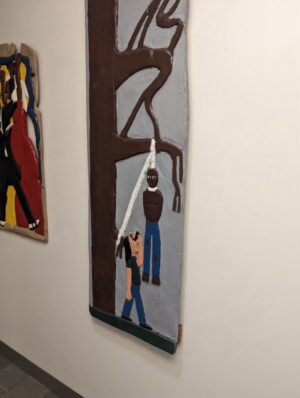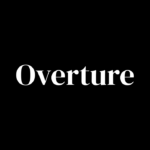Biglaw Firm Admits To 'Painful' Mistake After Displaying Lynching Artwork
That's a pretty big whoopsie.
 There is something soulless about most corporate art. Be it faux-magnificent steel sculptures that could be the cover of an Atlas Shrugged reprint or those humanoid paper maché abominations Big Tech keeps shoving down our throats, it can be refreshing to see art displayed in a business that has that je ne sais quoi associated with realness and raw feeling.
There is something soulless about most corporate art. Be it faux-magnificent steel sculptures that could be the cover of an Atlas Shrugged reprint or those humanoid paper maché abominations Big Tech keeps shoving down our throats, it can be refreshing to see art displayed in a business that has that je ne sais quoi associated with realness and raw feeling.
All that said, a good rule of thumb is that you shouldn’t be displaying dead bodies at law firms — and someone at Duane Morris should have gotten the memo:


Legal AI Tools And Assistants Essential For Legal Teams

A tipster notified us that a couple paintings were mounted on a wall without a placard. That’s no crime on its own. But, when one of the paintings depicts what looks like a man recording a lynching victim, you should expect people to scramble for context. This is part of the firm’s response:
Duane Morris is committed to providing a safe and supportive working environment at our offices. Recently, privately owned artwork was installed – by non-Duane Morris personnel and without Duane Morris management’s knowledge – at our Philadelphia headquarters and we acknowledge this particular artwork was disturbing and painful. It was installed after normal business hours and the following morning when Firm management discovered the work, they immediately took it down. Our Firm Chairman Matthew A. Taylor and Chief Diversity, Equity and Inclusion Officer and partner Joseph K. West subsequently conducted a video meeting with the Firm’s Black/African American Attorneys and Black/African American Staff ERG organizations, which was attended by more than 100 attorneys and staff members. During this meeting, our Chairman apologized for this mistake to the group personally and on behalf of the Firm.
We will continue to work collectively to learn from this event, as it does not reflect our Firm values.
The artwork is from 20th century African American artist Herbert Singleton, whose work depicts images of the poverty, violence and crime he experienced growing up in the American South.
This piece was not appropriate for display at our law firm, regardless of individual views on art and the purpose of art in our society. It is part of a private, world-renowned collection of “Outsider Art” owned by a retired partner and was installed by non-firm personnel.
In short: late at night, when no employee or member of higher management that could be held responsible was present, unnamed art aficionados with poor taste installed a portrait of a lynched man — we are just as shocked as you are!
This reverse burglary narrative would make more sense if it was actually just some hype building for the second season of Lupin.
Sponsored

From AI To KPI: The Law Department Tech Trends Of 2024

Diving Into Generative AI: A Practical Guide For Law Firms Starting From Scratch

Legal AI Tools And Assistants Essential For Legal Teams


From AI To KPI: The Law Department Tech Trends Of 2024
The firm’s statement went on to note that when a piece of art gets taken down for curation and conservation reasons, another is hung in its place, as happened here. You mean to tell us that some unidentified, non-firm employee is entrusted to unilaterally decide which paintings from a retired partner’s collection of artwork gets displayed, but lacks the common sense to think, “Hey, dead body on floor 12 might not be the best look for the firm”? The pieces of the art collection –presumably owned by Sheldon Bonovitz — are interesting and worth reading about. This piece in particular would be great for a museum. Little weird to be in someone’s living room but hey, decorate your castle. But decorating a workplace corridor with a sprinkle of terror for the sake of rawness is a gross commodification of grittiness that Thelonius Ellison spends half a movie lambasting. Things are clearer with hindsight, but whoever is responsible for hanging this picture really should have known better.
The firm’s complete response is on the next page.
 Chris Williams became a social media manager and assistant editor for Above the Law in June 2021. Prior to joining the staff, he moonlighted as a minor Memelord™ in the Facebook group Law School Memes for Edgy T14s. He endured Missouri long enough to graduate from Washington University in St. Louis School of Law. He is a former boatbuilder who cannot swim, a published author on critical race theory, philosophy, and humor, and has a love for cycling that occasionally annoys his peers. You can reach him by email at cwilliams@abovethelaw.com and by tweet at @WritesForRent.
Chris Williams became a social media manager and assistant editor for Above the Law in June 2021. Prior to joining the staff, he moonlighted as a minor Memelord™ in the Facebook group Law School Memes for Edgy T14s. He endured Missouri long enough to graduate from Washington University in St. Louis School of Law. He is a former boatbuilder who cannot swim, a published author on critical race theory, philosophy, and humor, and has a love for cycling that occasionally annoys his peers. You can reach him by email at cwilliams@abovethelaw.com and by tweet at @WritesForRent.
Sponsored

Referral Fees The Key To Growing A Modern Practice? Overture Thinks So.








